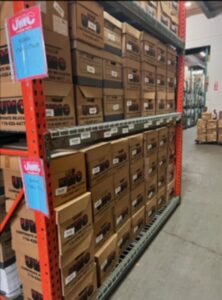-
Pre-Move Checklist for Moving Services in the New York Metro Area
The Ultimate Pre-Move-Out Inspection Checklist
Position your upcoming move for success with UMC Moving, the leading choice for unparalleled office moving services in the vibrant New York Metro Area. With over two decades of proven
expertise, we understand that every move is unique, and our dedicated team is committed to ensuring a seamless experience. Explore our comprehensive pre-move-in checklist, designed to cover
every detail of your office transition, from meticulous planning to efficient execution. Trust UMC Moving to navigate your move with precision and care. Ready to make your move stress-free and successful? Contact us today to get started and experience the difference of personalized moving services tailored to your needs.Office Pre-Move Checklist
Embarking on an office move? Streamline the process with our pre-move checklist designed to ensure a smooth transition. Follow these essential steps to minimize stress and maximize efficiency as you prepare for the relocation:
- Throw Things Away – Begin by decluttering your office space. Dispose of unnecessary items, outdated equipment, and irrelevant documents. A clutter-free environment not only lightens the load for the move but also sets the stage for a fresh start in your new workspace.
- File Papers Electronically – Digitize important documents and files to reduce the reliance on paper during the move. Embracing electronic filing systems not only streamlines the packing process but also enhances accessibility and organization in your new office.
- Ask Each Employee to Pack Up Their Own Desk – Distribute responsibility by having employees pack their own desks. This empowers individuals to manage their personal belongings and ensures that each employee’s workspace is organized according to their preferences in the new location.
- Bring In the Professionals for Cleaning and Moving – Enlist the expertise of professional cleaning and moving services to handle the logistics of the move. This not only frees up your team to focus on essential tasks but also ensures that the process is executed efficiently and with care.
- Deep Clean the New Space – Prepare your new office space by conducting a thorough deep clean before the move. This ensures a fresh and welcoming environment for your team upon arrival, setting the stage for a positive and productive start in the new location.
- Update Contact Information – Before the move, update your business’s contact information on your website, social media, and any other platforms. Notify clients, vendors, and partners of the impending relocation to maintain open communication during the transition.
- Create an Inventory Checklist – Develop a detailed inventory checklist of office furniture, equipment, and other assets. This not only helps in tracking items during the move but also facilitates a smoother unpacking process at the new location.
- Establish a Temporary Workstation Setup – Plan for a temporary workstation setup at the new location before the official move. This ensures that essential work can continue during the transition, minimizing downtime for your team.
- Coordinate IT Infrastructure Transfer – Work closely with your IT department or service provider to ensure a seamless transfer of digital infrastructure. This includes backing up data, transferring servers, and testing the functionality of essential systems in the new office space.
- Inform Utilities and Service Providers – Contact utility companies, internet service providers, and other essential service providers to inform them of your upcoming move. Ensure utilities are set up and ready at the new location to avoid operational interruptions.
Contact UMC Moving
As you gear up for your next office move in the dynamic New York Metro Area, trust UMC Moving to be your steadfast partner for a seamless transition. Our commitment to excellence, backed by over 20 years of industry experience, ensures that your moving experience is stress-free and meticulously planned. Explore the advantages of our pre-move-in inspection checklist, a comprehensive guide designed to cover every detail of your professional relocation process. With UMC Moving, you’re not just moving; you’re moving with confidence. Contact us today to schedule your move and discover the unparalleled service that sets us apart in the world of moving.
-
What Is Office Liquidation?
If you think your corporate relocation in New York City is done once you’ve moved your belongings into your new space, think again. You’ll also have to clear out your old space and make sure it’s left in a “broom swept” condition. This means you can’t leave anything behind, or you’ll be slapped with fees and premiums for the extra work that your landlord will have to do before being able to find a new tenant. If you want to avoid the fees but you don’t have the time or capability of cleaning out your old office, then you need office liquidation services .

You can’t just abandon your old office once the important stuff is gone, but you might not be able to get back there and clean it out, either. Office liquidation is the process of breaking down any cubicles and furniture left behind, getting rid of the clutter and garbage, and handling the cleanup. It’s also a service that many office relocation companies offer. Leases typically mandate that the space is left in a “broom swept” condition, so the space should look like it did when you first saw it.
-
NYC’s Business Improvement Districts
Getting off the ground can take time for a small business that’s just starting up, but moving to a business improvement district can help. This kind of relocation in New York City helps businesses, customers, and the community as a whole. Watch this video and find out what business owners should know about NYC’s business improvement districts.
New York City’s business improvement districts aim to enhance the community by bringing all aspects of it together. Small businesses, residents of the area, and property owners all stand to benefit in their own ways. Businesses get more attention from prospective customers as well as the ability to network with other owners, property owners can fill vacant spaces with incoming businesses, and shoppers can buy products from local vendors who live in the community. Customers tend to create stronger bonds with business owners when they know they live locally, so the neighborhood thrives.
-
Records Keeping for Small Business Owners
Keeping records is an essential part of doing business, but it can also be confusing and even burdensome to small businesses, who are already trying to juggle demanding workloads. Although you canât skip your records keeping responsibilities as a business owner, you can find effective ways to manage them. Here is what you need to know about business record retention in NYC for your small company.
Retain the Source Documents
Ideally, the records you keep should be the original, source documents, rather than copies. For financial records, this means keeping canceled checks, cash register tapes, credit card slips, and financial statements from your bank. Corporate documents, such as meeting minutes, property mortgages and leases, charters, licenses, and copyrights, should also be original documents. If you need to produce this information for tax purposes or a legal case, having the originals can be very important.
Know How Long to Keep Records
Some documents, such as those that are related to establishing your business, should be kept indefinitely. Records retention for tax purposes is different. Generally, you should hold on to tax records for as long as the IRS could request them. Employee records should be kept for four years. Keep records of taxes owed for at least three years. The IRS has different rules for a variety of different business documents, which can be found on their website . Your business accountant can also help you determine how long record retention is necessary for financial documents.
Use Off-Site Storage
Not only does retaining records off-site make sense from a space perspective, but it is also safer and more secure. An off-site records retention facility will provide your important documents with greater security from fire, flood, theft, humidity, and other issues. Your records will also stay organized so that they are easy to access when you need them, and tracking software will let you know when the records were accessed and who accessed them, adding an extra layer of security.

